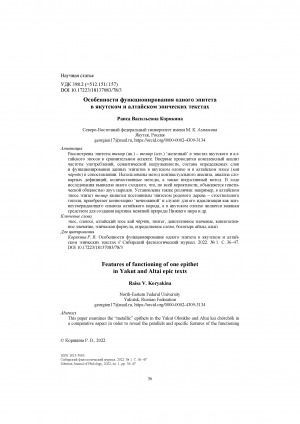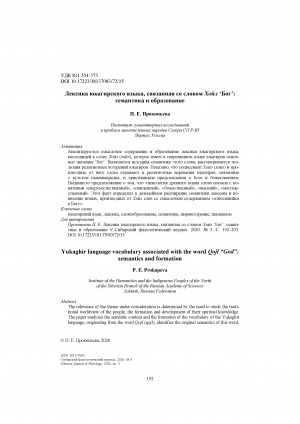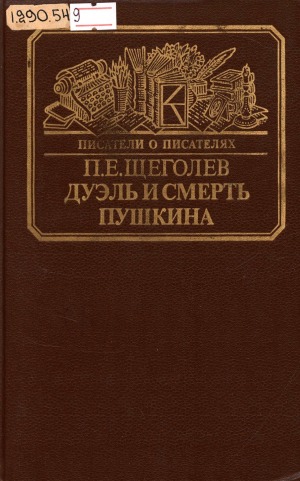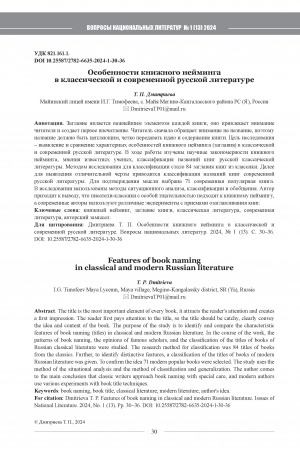- Книга (6970)
- Журнал (249)
- Автореферат диссертации (191)
- Аудиоиздание (750)
- Видеоиздание (659)
- Неопубликованный документ (17)
- Нотное издание (7)
- Фотография (4)
- Статья (958)
- Библиографический указатель (51)
- Словарь (209)
- Календарь (2)
- Брошюра (104)
- Буклет (1)
- Электронное издание (1)
- Грампластинка (19)
- Веб-архив (289)
- Азербайджанский (1)
- Чукотский (18)
- Долганский (10)
- Английский (59)
- Эскимоский (1)
- Эвенкийский (56)
- Эвенский (135)
- Французский (29)
- Немецкий (10)
- Хантыйский (1)
- Казахский (5)
- Корякский (3)
- Корейский (1)
- Мансийский (1)
- Нанайский (6)
- Ненецкий (3)
- Нивхский (5)
- Старорусский (6)
- Осетинский (1)
- Польский (1)
- Русский (5581)
- Латинская графика (214)
- Тунгусский (3)
- Турецкий (19)
- Тувинский (5)
- Якутский (4273)
- Юкагирский (35)
Количество страниц: 12 с.
- Общественные науки. Образование > Народное образование. Воспитание. Обучение. Организация досуга > Общеобразовательная школа. Дошкольные учреждения,
- Языкознание. Филология. Художественная литература > Языкознание и языки. Лингвистика > Эвенкийский язык,
- НАУКА ЯКУТИИ > ЯЗЫКОЗНАНИЕ. ФИЛОЛОГИЯ. ЛИТЕРАТУРОВЕДЕНИЕ. ХУДОЖЕСТВЕННАЯ ЛИТЕРАТУРА > Языкознание и языки. Лингвистика,
- НАУКА ЯКУТИИ > ОБЩЕСТВЕННЫЕ НАУКИ > Народное образование. Воспитание. Обучение. Организация досуга > Общеобразовательная школа. Дошкольные учреждения.
The main purpose of the study was to analyze the lexical units involved in the representation of the URE ‘mountain’ concept in the language picture of the world of the Evenks. The identification of word meanings involved the examination of bilingual dictionaries of the Evenk language and field records of authentic texts narrated by informants who knew the Evenk and Russian languages well. According to the source study, the lexemes ure , a , and are the most commonly used representations of the concept URE in the Evenks’ world picture. The analysis revealed the meaning of lexemes ure , a , and allowed their semes to be identified. The ure lexeme was found to have the semes: ‘overgrown with trees,’ ‘low hill,’ ‘inhabited by moose, bears, and other wild animals,’ and ‘master spirit of the mountain.’ The following semes were found for the lexeme : ‘stony,’ ‘covered with grass or reindeer moss,’ ‘inhabited by wild deer,’ ‘suitable for residence in summer,’ suitable for roaming,’ ‘suitable for deer grazing in summer,’ and ‘a good place for hiding deers from wolves.’ The lexeme is characterized by the semes: ‘rocky,’ ‘high,’ ‘made of stones,’ ‘cool place,’ and ‘inhabited by bighorn sheep, tarbagans, and musk deer.’ A conclusion is made that the URE ‘mountain’ concept formation was influenced by Evenks’ hunting and nomadic lifestyle combined with their animistic views on nature. The URE ‘mountain’ concept is a part of the BUGA ‘world’ concept structure.
Ушницкая, Н. Ю. Репрезентация концепта УРЭ ‘гора’ в языковой картине мира эвенков / Н. Ю. Ушницкая ; Институт гуманитарных исследований и проблем малочисленных народов Севера // Сибирский филологический журнал. - 2023. - N 4. - С. 287-298. - DOI: 10.17223/18137083/85/21
DOI: 10.17223/18137083/85/21
Количество страниц: 14 с.
The paper presents a structural description of the terminological phrases relating to the thematic group “Livestock body parts” in the Yakut and Buryat languages. These lexical units refer to the folk terms reflecting the features of the material and spiritual culture of an ethnic group and are widely used in languages of very different typologies. Such phrases are formed analytically, representing non-single-word nominative units denoting one specific concept or real object. Their lexical meaning can be realized at the denotative and/or connotative levels. The terminological phrases under study occupy a special place in the lexicon of the languages in question as an effective way of creating terms. Word pairs are a part of this vocabulary group. An active way of compound word formation in Yakut and Buryat is the method of adjunction used to form attributive phrases with an adjective or a participle as an attribute. Both languages feature terminological phrases formed morphologically. Such phrases have an attributive function, designating a part of a whole object or a type of a generic concept, with the determining component occupying the preposition. In Yakut, these phrases have their components connected by the possessive affix of the third person. Buryat terms denoting animal body parts are formed by a combination with the determining component in the genitive case. It is noteworthy that in Yakut nominal constructions, the indicator of the connection between the components is attached to the component being determined, while in Buryat, it is attached to the determining one.
Данилова, Н. И. Терминологические словосочетания, обозначающие части тела скота, в якутском языке (в сопоставлении с бурятским) / Н. И. Данилова, Ф. Н. Дьячковский ; Институт гуманитарных исследований и проблем малочисленных народов Севера // Сибирский филологический журнал. - 2023. - N 4. - С. 197-210. - DOI: 10.17223/18137083/85/15
DOI: 10.17223/18137083/85/15
Количество страниц: 14 с.
This paper addresses the semantics of dialectal names of mutovka (a stick with branches at the end used for mixing or stirring), with all of them belonging to the lexical-thematic microgroup “Utensils” in the Yakut language. Over 40 dialect names of mutovka with different connotations have been identified in dialectological, lexicographical, and ethnographic materials. The nomination principles of mutovka are determined on the external form and functions. The form and structure of mutovka s (round, branched, cross-shaped), material (wood, cow horn) depend on their purpose. Mutovka has different functions: for whipping koumiss, cream, or butter, and others, with the movement of the tool also of importance for nomination. The basic characteristic of any mutovka is ytyyyy “mixing, stirring, and churning.” The comparative analysis revealed that the Yakut lexemes ytyk and bhiheyeh indicate a common Turkic similarity. Most names of mutovka are part of the lexical fund of the Yakut language developed in the linguistic landscape of modern Yakuts (Sakha). Also, the dialect names bilier, biriel “kumys mutovka” have been found to have Mongolian roots. A semantic description allowed the origin of khamnatar “kumys mutovka” to be determined as an apotropaic lexeme with both all-Yakutian and dialectal meaning. The semantics of the mutovka names concerned reflects the cattle-breeding culture of Yakuts (Sakha) developed and spread in the subcontinental climate in the vast territory of the North-East of Russia. The findings specify the lexical-semantic microgroups “Tableware,” “Utensils” to “Kumys ware and utensils,” “Ytyk,” to compile the thematic lists of Yakut household culture.
Николаев, Е. Р. Диалектные наименования мутовки в якутском языке (на материале лексикографических источников) / Е. Р. Николаев ; Институт гуманитарных исследований и проблем малочисленных народов Севера // Сибирский филологический журнал. - 2023. - N 2. - С. 194-207. - DOI: 10.17223/18137083/83/15
DOI: 10.17223/18137083/83/15
Количество страниц: 12 с.
- Языкознание. Филология. Художественная литература > Языкознание и языки. Лингвистика > Якутский (саха),
- Языкознание. Филология. Художественная литература > Языкознание и языки. Лингвистика > Другие языки,
- НАУКА ЯКУТИИ > ЯЗЫКОЗНАНИЕ. ФИЛОЛОГИЯ. ЛИТЕРАТУРОВЕДЕНИЕ. ХУДОЖЕСТВЕННАЯ ЛИТЕРАТУРА > Языкознание и языки. Лингвистика.
This paper examines the “metallic” epithets in the Yakut Olonkho and Altai kai chӧrchӧk in a comparative aspect in order to reveal the parallels and specific features of the functioning of these epithets in the epic of peoples related in the historical past. The following methods were used: contextual analysis, analysis of dictionary definitions, quantitative methods, and the inductive method, which allows generalizing the results of applying all the methods. The comparative study revealed many similarities. In both epics, metal epithets in the structure are radical, derived from the lexeme denoting the name of the metal. In a denotative meaning, they characterize objects by the material from which they are made. The choice of specific metallic epithets as contextual synonyms in the structure of the epic formula is due to the phenomenon of vowel harmony inherent in most Turkic languages. The genetic community of the Yakut and Altai peoples probably explains the similar features of the metallic epithets. Also, the differences have been established: according to the frequency of using the epithets formed from the nominations of precious metals, the ancient Yakuts preferred silver, and the Altai people preferred gold. The differences and peculiarities of functioning of “metal” epithets in the Yakut and Altai epic texts can be explained by the stage difference in the development of the epic texts compared.
Корякина, Р. В. Особенности функционирования одного эпитета в якутском и алтайском эпических текстах / Р. В. Корякина ; Северо-Восточный федеральный университет им. М. К. Аммосова // Сибирский филологический журнал. - 2022. - N 1. - С. 36-47. - DOI: 10.17223/18137083/78/3
DOI: 10.17223/18137083/78/3
Количество страниц: 12 с.
The relevance of the theme under consideration is determined by the need to study the traditional worldview of the people, the formation and development of their spiritual knowledge. The paper analyzes the semantic content and the formation of the vocabulary of the Yukaghir language, originating from the word Qojl (qojl), identifies the original semantics of this word, examines the evolution of the religious beliefs of the Yukaghir. The word Qojl (qojl) is associated originally with shamanistic beliefs and was representing the image of the shaman-patron of the family in the traditional culture of the Yukaghir. Later, it came to be referred to the name of the Christian God and to designate icons and saints. In the modern Yukaghir language, the word concerned is used only in the meanings of “God,” “divinity,” “icon,” “saint.” The prevalence of Qojl (qojl) - derived words in the languages of two local Yukaghir groups, the similarity of the structure and meanings of many of the lexemes indicate the archaicity of the word and the presence of a semantic relationship between the original and late sememes. An assumption has been made that the etymology of the ancient root of the word is associated with the concepts of “supernatural,” “sacred,” “divine,” “supreme,” “powerful.” The fact that the word originally comprised the concept of the supernatural and divine determined the expansion of the semantics of the word. Under the influence of Christianity, new words derived from Qojl ( qojl ), with the semantic content “referring to God,” appear in the Yukaghir language.
Прокопьева, П. Е. Лексика юкагирского языка, связанная со словом Хойл ‘Богʼ: семантика и образование / П. Е. Прокопьева ; Институт гуманитарных исследований и проблем малочисленных народов Севера СО РАН // Сибирский филологический журнал. - 2020. - N 3. - С. 76-80. - DOI: 10.17223/18137083/72/15
DOI: 10.17223/18137083/72/15
Издательство: Книга
Год выпуска: 1987
Количество страниц: 584 с.
Количество страниц: 3 с.
- Общественные науки. Образование > Народное образование. Воспитание. Обучение. Организация досуга > Общеобразовательная школа. Дошкольные учреждения,
- Языкознание. Филология. Художественная литература > Литература. Литературоведение > Теория литературы. Изучение литературы. Литературная техника > Художественная литература на отдельных языках,
- НАУКА ЯКУТИИ > ОБЩЕСТВЕННЫЕ НАУКИ > Народное образование. Воспитание. Обучение. Организация досуга > Общеобразовательная школа. Дошкольные учреждения,
- НАУКА ЯКУТИИ > ЯЗЫКОЗНАНИЕ. ФИЛОЛОГИЯ. ЛИТЕРАТУРОВЕДЕНИЕ. ХУДОЖЕСТВЕННАЯ ЛИТЕРАТУРА > Литература. Литературоведение.
This article contains practical materialfrom the experience of primary school teachers in theformation of reading literacy. Of particular interest arethe descriptions of methodological methods of work inthe classroom related to the development of the creative abilities of younger students.
Шматкова Т. Я. Формирование читательской грамотности через развитие творческих способностей у младших школьников / Т. Я. Шматкова, С. Д. Сивцева, З. Е. Андреева ; МОБУ "Средняя общеобразовательная школа N 31" // Народное образование Якутии. - 2023. - N 2 (127). - С. 79-81.
Количество страниц: 7 с.
- Языкознание. Филология. Художественная литература > Литература. Литературоведение > Теория литературы. Изучение литературы. Литературная техника > Художественная литература на отдельных языках,
- НАУКА ЯКУТИИ > ЯЗЫКОЗНАНИЕ. ФИЛОЛОГИЯ. ЛИТЕРАТУРОВЕДЕНИЕ. ХУДОЖЕСТВЕННАЯ ЛИТЕРАТУРА > Литература. Литературоведение.
Дмитриева, Т. П . Особенности книжного нейминга в классической и современной русской литературе / Т. П. Дмитриева ; Майинский лицей имени И. Г. Тимофеева // Вестник Северо-Восточного федерального университета им. М. К. Аммосова. Серия "Вопросы национальных литератур". - 2024. - N 1 (13). - С. 30-36. - DOI: 10.25587/2782-6635-2024-1-30-36
DOI: 10.25587/2782-6635-2024-1-30-36
Количество страниц: 14 с.
- Языкознание. Филология. Художественная литература > Литература. Литературоведение > Теория литературы. Изучение литературы. Литературная техника > Художественная литература на отдельных языках > Якутская (саха) литература,
- НАУКА ЯКУТИИ > ЯЗЫКОЗНАНИЕ. ФИЛОЛОГИЯ. ЛИТЕРАТУРОВЕДЕНИЕ. ХУДОЖЕСТВЕННАЯ ЛИТЕРАТУРА > Литература. Литературоведение.
In his works, Dmitry Naumov created a special social and spiritual “microcosm” in the image of the Yakut village Charannaakh, since, in his opinion, the national identity of the Sakha people is formed precisely in rural areas. The writer's stories demonstrate a number of intra-genre varieties, starting with the main types of short prose – the actual story, short story, essay – and ending with synthetic and hybrid forms of short epic genres. Naumov's short stories feature satirical stories directed against bureaucrats, careerists, and lovers of the “green serpent”. Many of them contain everyday comedy, and in a number of the writer’s stories one can feel the features of the so-called “mischievous”tradition known in world literature, which often borders on “black” humor. Naumov’s humor is of a soft,“hinting” nature, and its meaning is hidden in allegories and subtext. A whole series of stories is dedicated to animals: the author’s bestiary includes horses, cows, dogs, cats, even piglets. The writer demonstrates extraordinary skill in creating crowd scenes and identifying the “collective consciousness.” At thesame time, his artistic anthropology contains many vivid individualized images. In many of Naumov’sstories one can feel his talent as a playwright. If the writer’s short stories demonstrate different types ofshort prose, then the genre designations of his dramatic works are limited to only two definitions – “play”in the sense of “drama” and “comedy”. The only dramatic work that is not accompanied by an author's genre definition is “Autumn.” Judging by the brief initial remark, adherence to the principleof “three unities,” the absence of external events, and the minimum of characters, this is a psychological monodrama. In his comedies, as in his stories, Naumov used a whole system of poetic means andtechniques, starting with such as literary allusions, poetics of names, animalistic imagery, and ending with the verbal self-disclosure of the characters. To enhance the ironic context, they mention the characters of S.S. Yakovlev-Erilik Eristin, poor Khachygyr, D. K. Sivtsev-Suorun Omollooa autocrat Makar, the “great strategist” Ostap Bender from the works of I. Ilf and E. Petrov, and adaptEllyai’s poems. Finally, Naumov himself is a brilliant expert on the native language, rightfully throws a stone at supporters of excessive “Yakutization” of the language of the Sakha people.
Бурцев, А. А. Проблематика и поэтика произведений Дмитрия Наумова / А. А. Бурцев, М. А. Бурцева ; Северо-Восточный федеральный университет им. М. К. Аммосова // Вестник Северо-Восточного федерального университета им. М. К. Аммосова. Серия: Вопросы национальных литератур. - 2024. - N 1 (13). - С. 5-18. - DOI: 10.25587/2782-6635-2024-1-5-18
DOI: 10.25587/2782-6635-2024-1-5-18
Количество страниц: 8 с.
- Языкознание. Филология. Художественная литература > Литература. Литературоведение > Теория литературы. Изучение литературы. Литературная техника > Художественная литература на отдельных языках,
- НАУКА ЯКУТИИ > ЯЗЫКОЗНАНИЕ. ФИЛОЛОГИЯ. ЛИТЕРАТУРОВЕДЕНИЕ. ХУДОЖЕСТВЕННАЯ ЛИТЕРАТУРА > Языкознание и языки. Лингвистика.
Teki Odulok's travel essay is the first work devoted to a journey through the northernmost regions of the Russian Federation undertaken by a compatriot, a representative of the smallest Russian people - the Yukaghir, in the 20s of the twentieth century. The article presents the results of the study of the content of the travelogue, its chronotopes, descriptions of nature at different geographical latitudes, culture and life of the unique endemic peoples inhabiting the territory: the Yukaghirs (Oduls), Russian-Ustintsy, Chukchi, Evens, Evenks (Lamuts). It is proven that the work is a narrative, objectively related to the history and geographical location of the region, political and cultural events in the Soviet Union at the beginning of the twentieth century. The novelty is justified by the fact that the essay has the characteristics of a travelogue in the modern sense, and therefore the readers, regardless of their nationality and place of residence, perceive it with interest. The influence of the professional view of a scientist-economist on the style of literary narration is shown, which provides an enriched description of travel along a specific route and an evidential connection with the modern economic state of the regions described. Complete discourses combining documentary narration, presentation of real facts about harsh conditions of survival and description of life and customs of representatives of small number of peoples - endemics - are highlighted. Methods of comparison and literary retroscopy were used, which allowed to confirm the author's assumptions about the development of the region in literary and documentary form. The article may be of interest not only to philologists and specialists in the field of national cultures, but also to interested readers.
Третьякова, Т. В. Путевой очерк Тэки Одулока "На Крайнем Севере" – первый травелог начала ХХ века / Т. В. Третьякова ; Северо-Восточный федеральный университет им. М. К. Аммосова // Вестник Северо-Восточного федерального университета им. М. К. Аммосова. - 2024. - Т. 21, N 1 (95). - С. 178-185. - DOI: 10.25587/2222-5404-2024-21-1-178-185
DOI: 10.25587/2222-5404-2024-21-1-178-185









